Category: "Milk products"
Сгущёнка
My former student Ryan is living in Kazan and studying. Despite his studying, he manages to spend some time with his girlfriend, Lila. Now Ryan is an excellent guy. He is one of those men who cooks and cleans and is communicative. Lila considers herself lucky. (Frankly, Lila is worth it. If I were thirty years younger and smarter than I myself had been at that age... well, nevermind.) Anyhoo, Lila asked Ryan to go to the store to get some sweetened, condensed milk. He went. And he said to the store attendant, «Я хочу мошонку» “I want scrotum.” I leave it to you to imagine the attendant's reaction.
The word Ryan was looking for was сгущёнка, not мошонка. The word comes from the root густ-, which means ‘thick’, from which we derive the verb сгущать/сгустить ‘to make thick’, hence сгущёнка means ‘stuff which has been thickened’, in this case specifically milk with sugar added. Here's a picture:
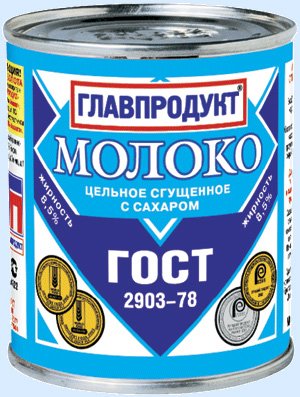
It declines like this:
| Sg | |
| Nom | сгущёнка |
| Acc | сгущёнку |
| Gen | сгущёнки |
| Pre | сгущёнке |
| Dat | |
| Ins | сгущёнкой |
The Russians love сгущёнка. Not only can you make various desserts with it, often Russians like to drink tea and then simply stick a spoon in the сгущёнка and have a mouthful. It is so good. Here are a few sentences.
| — Я люблю чай со сгущёнкой. Ты сгущёнку любишь? — Нет, я не большой любитель сладкого. |
“I love tea and sweetened, condensed milk. Do you like sweetened, condensed milk?” “No, I'm not a big fan of sweets.” |
| Хотя этот торт очень вкусный, он приготовлен без сгущёнки. | Although this cake is very tasty, it was made without sweetened, condensed milk. |
| Фу! В сгущёнке плавает муха! | Yuck! There's a fly floating in the sweetened, condensed milk! |
| А задумывались ли вы, что на самом деле, сгущёнка еще и гораздо полезней многих других сладостей – она содержит кальций и молочный белок, в ней нет красителей, дрожжей или усилителей вкуса. (source) | But have you ever thought that, really, sweetened, condensed milk is still much healthier than many sweets? It contains calcium and milk protein. It has no coloring agents, yeast or flavor additives. |
Now a comment on the power of branding. As I was growing up, the most popular brand of sweetened, condensed milk was Eagle Brand. It was so popular that no one ever said ‘sweetened, condensed milk.’ We just said ‘Eagle Brand.’ For instance, we could have a conversation like:
“Will do.”
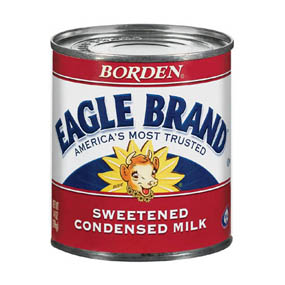
Nowadays there are generic versions of sweetened, condensed milk as well, but if I ever have a conversation with my mother, I'm sure we will not say ‘sweetened, condensed milk.’ We will say ‘Eagle Brand’ and know exactly what the other means.
Кефир
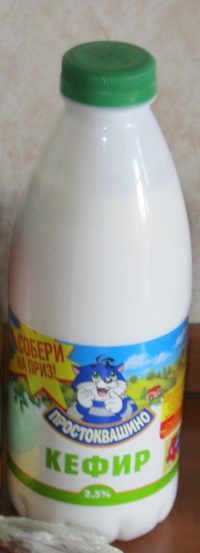 Another of the Russians' favorite fermented milk products is кефир kefir. You take milk, mix it with bacterial and yeast cultures, let it ferment for one or two or three days, and then bottle it. Usually it is made from cow's milk, but it's possible to use sheep or goat's milk as well. Compared to ряженка it is rather more acidic and slightly carbonated. The alcohol content in commercial kefir in Russia is usually less than 1%. It actually has live cultures in it, so it colonizes your gut with friendly flora that may have beneficial effects in human beings.
Another of the Russians' favorite fermented milk products is кефир kefir. You take milk, mix it with bacterial and yeast cultures, let it ferment for one or two or three days, and then bottle it. Usually it is made from cow's milk, but it's possible to use sheep or goat's milk as well. Compared to ряженка it is rather more acidic and slightly carbonated. The alcohol content in commercial kefir in Russia is usually less than 1%. It actually has live cultures in it, so it colonizes your gut with friendly flora that may have beneficial effects in human beings.
| Sg | |
| Nom | кефир |
| Acc | |
| Gen | кефира |
| Pre | кефире |
| Dat | кефиру |
| Ins | кефиром |
Most Americans' only exposure to cultured dairy products is to yogurt, usually flavored with sugar or fruit in the US, or sour cream as part of dips or dressings. So when Americans are first are exposed to kefir, they usually have a negative reaction. I didn't care for it at first, but now I really like it; and the American version that they sell in places like Whole Foods that is flavored with sugar and fruit... well, it's edible in a long-term toxic sort of way, but it's nothing like Russian kefir. Let's see some sample sentences:
| — Ты любишь кефир? — Очень. |
“Do you like kefir?” “Very much.” |
| —Ты хочешь кефира? — Хочу. |
“Do you want some kefir.” “I do.” |
| Ни в одном из магазинов белорусской столицы кефира в продаже нет. | Not a single store in the Belarusian capital has kefir for sale. |
| Скажи кефиру «Нет»! (source) | Just say ‘no’ to kefir! |
| Похудеть на кефире: всю неделю нужно пить пол-литра кефира до четырёх часов дня. (adapted from this source) | Lose weight on a kefir: all week long you need to drink half a liter of kefir by four o'clock in the afternoon. |
| Я обожаю острую пищу с кефиром — варишь макароны, на сковородке жаришь лук и красный перец, потом добавляешь черный перец, в блюдо наливаешь кефир и макароны, и со сковородки всё выкладываешь и сверху трёшь чеснок! Так остренько и вкусненько получается! (adapted from this source) | I love to make spicy dishes garnished with kefir. You boil some pasta. In a frying pan saute onions plus red pepper, then add black pepper. Into a dish you pour the kefir and the pasta, and you pour out everything from the frying pan and mince some garlic. It turns out nicely spicy and yummy! |
Now what about the nutritional value of kefir? Here's the label.

Fat — 2.5 g; protein — 2.8 g; carbohydrate — 4.0 g.
Energy value (caloric value)
per 100 g of product — 50 calories
Now that's interesting. In terms of its fat content it's about the same as ряженка.
Ряженка
The Russians drink a variety of fermented milk products and one of them is ряженка. You take milk, mix it with a bacterial culture, let it ferment for six to eight hours, then bring the process to a close. Essentially it is a type of yogurt without any flavor additives. Compared to кефир kefir, it's flavor is less acidic. We have no special word for this in English, so we usually just transliterate it as ryazhenka. It declines like this:
| Sg | |
| Nom | ряженка |
| Acc | ряженку |
| Gen | ряженки |
| Pre | ряженке |
| Dat | |
| Ins | ряженкой |
This last week I bought a packet of ряженка at the store. That's right: in Russia cold liquids are often sold in plastic packets. Here you can see it on the left. I drink about half a packet at a time, pouring it into a glass, which you can see on the left:
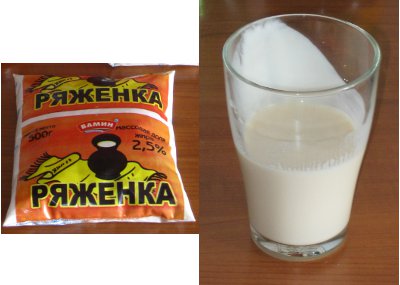
Now a thoughtful homemaker will wonder, “If it is in a floppy plastic bag, how the heck am I supposed to store an opened packet in the fridge?” Why, you stand the packet up in a mug, of course!
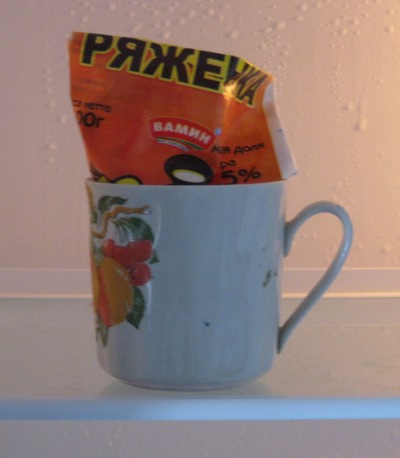
Let's see the word in some sentences:
| — Где тут можно купить ряженку? — За углом, в «Пятёрочке». |
“Where can I buy ryazhenka?” “Around the corner at the Pyatyorochka [store].” |
| Ряженка — кисломолочный напиток, получаемый из коровьего топлёного молока молочнокислым брожением. (source) | Ryazhenka is a fermented milk product made from heated cow's milk by lactic (acid) fermentation. |
| Ненавижу Америку. Там нет ряженки. А что я должна пить на завтрак? ¹ | I hate America. There's no ryazhenka there. So what am I supposed to drink for breakfast? |
| Я обожаю холодный ягодный суп с ряженкой. (recipe) | I adore cold berry soup with ryazhenka. |
Since I'm trying to limit my carb intake this summer, I of course am now wondering what the carb load is. Here's the ingredient lable. The words that appear first are in Tatar, since I am living in Kazan, and the words that follow are in Russian:
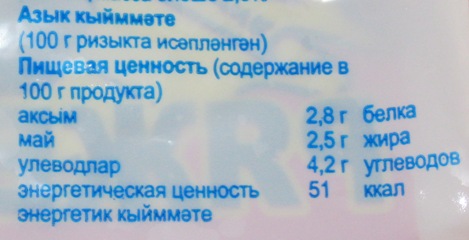
They mean:
| Nutritional value | (per 100 g) |
| Protein | 2.8 g |
| Fat | 2.5 g |
| Carbohydrates | 4.2 g |
| Calories ² | 51 |
Hm. Let's see. 100 mg of ryazhenka has 4.1 g of carbs. I'm limiting myself to 20 g of carbs a day. If a glass is 250 mg, then that's roughly 10 g of carbs for a glass of ryazhenka. Damn. That's half the day's carbs right there. Guess that means that leaves only meat and fat for the rest of the day. Actually, I can live with that.
¹ This was actually said by a Russian woman visiting the US. We had no kefir, no ryazhenka, no tvorog. It was like there was no human food there at all!
² Note to Russian readers: in the US when listing nutritional information, the word "calorie" means "kilocalorie". So for a nutritional discussion, "calorie" is a proper translation for ккал, even though in the metric system that is properly translated kilocalorie.